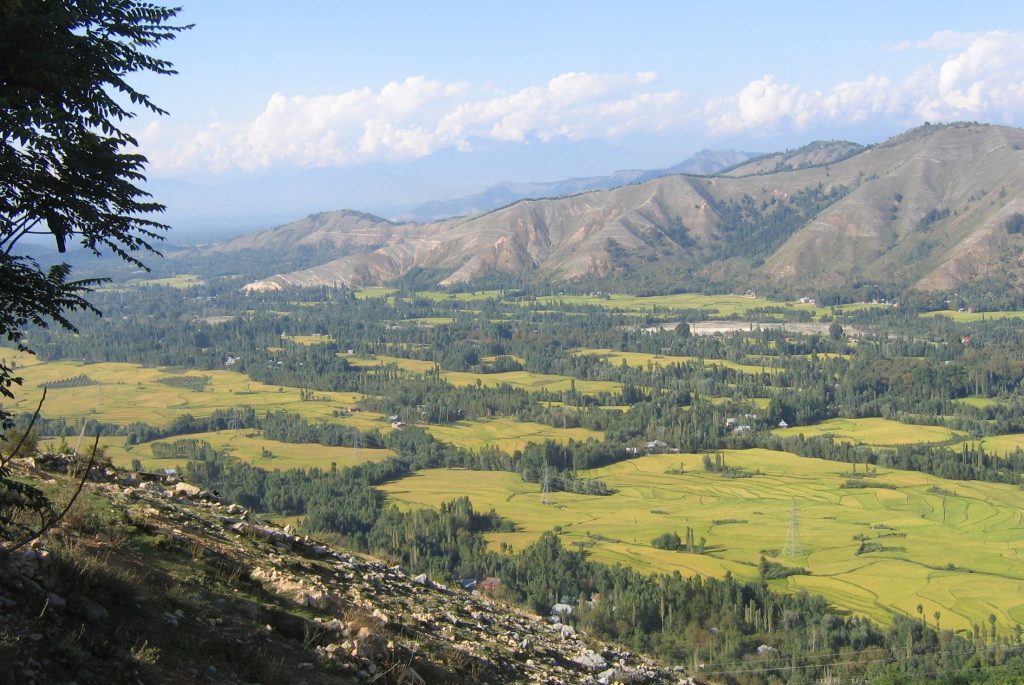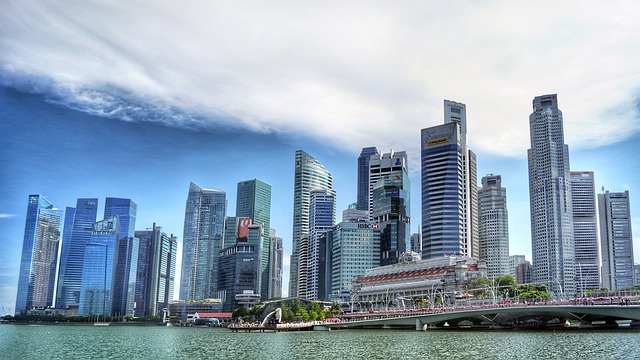
Kashmir, the paradise on earth, with azure skies, falling leaves, snow-capped mountains, cool breeze and the Chinar beckons the tourist like no other place in India. The placid waters of the Dal Lake, floating shikaras and well laid out gardens all add to the romantic ephemeral charm of the land called Kashmir.

The Journey – Winding Roads and Breath-taking Natural Beauty
It was early in the morning when we started from Jammu. There was a slight drizzle, but the weather cleared after a while. Such changes in the weather are a common phenomenon in the valley. After crossing the 2.5 km long Jawahar Tunnel, we finally entered Kashmir.
The road to Srinagar is a scenic but difficult drive due to the winding roads. I marvelled at the giant pine trees which lined the road. On the way, we crossed small towns each offering its own appeal to the visitor – Qazigund, famous for its dry fruits; Anantnag, a historic town with numerous springs; Avantipur and its famous temples; Pampore, renowned for its saffron.
Finally, after almost eight hours of drive, I reached Srinagar. At first glance, it looked like a fortress which had been taken over by the Army. At every corner and junction there was armed personnel giving the city a kind of forbidding look, but as we drove through the Badami Bagh Cantonment, the place began to take on a more hospitable hue.
We had booked a hotel near Dal Lake – the customary spot where all tourists stay.
Dal Lake – The Jewel of Kashmir
I began my tour from the Dal Lake which is the main attraction of Srinagar. The residents of the lake have lived here since ages.
Dal Lake is integral to the tourism of Kashmir and is called “The Jewel in the Crown “. The water of the lake is crystal clear and is interspersed with floating gardens where one gets to see pretty lotus flowers blossoming in all their glory. It is also an important source of income for the locals who fish and harvest plants in its fertile waters.
A fascinating aspect of the Dal Lake is the floating vegetable market. It’s a treat to see locals vigorously bargaining and conducting the brisk business of buying and selling their wares. After our trip to the floating markets, we went past the ‘Char Chinari’ – an island with four huge Chinar trees- very picturesque and alluring.
Sunset on the Dal was magical – the changing colours of the sky, the houseboat lights, birds tweeting and settling for the night, the omnipresent shikaras and the distant Char Chinar all beckoning us to stay another day and enjoy its pristine beauty.
House Boats And Shikaras – An Abode For Honeymooners
The houseboat booked for us was called ‘The Shining Star’. The entire interiors had intricate wooden carvings and Kashmiri furnishings. I was fascinated by the boatman who was an all-in-one personality – a wonderful host, a great cook, a helpful guide and above all an adept boatman.
After spending a lovely night on the houseboat, we hired a shikara early next morning to go around the Dal Lake. It was a great experience. These small boats seating two to eight people glide effortlessly under the skilful manoeuvrings of the boatman. Daintily decorated it gives a ‘honeymoon’ feel to its occupants.

I got addicted to the shikara trips – lying lazily watching boats passing by and enjoying the crisp winter sun.
Gardens – The Largesse of the Mughals
From the Dal Lake’s shoreline, you can witness the scenic beauty of the Mughal gardens. Built during the reign of the Mughal Emperor Jahangir, Shalimar Bagh and Nishat Bagh are spectacular gardens where we spent the whole morning.

The Mughal gardens built in the Islamic style of architecture were greatly influenced by Persian and Timurid gardens. Considerable use of rectilinear layouts is made within the walled enclosure.
Our next stop was Cheshm-e-Shahi, a stunning garden situated at a distance of about eight kilometres from Srinagar. The garden was developed around a natural spring known today as The Royal Spring. Water from the spring flows through a network of canals and gushes out as refreshing fountains.
Hazrat Bal – A Holy Shrine
Located on the west bank of Dal Lake is the famous mosque of Hazrat Bal. It is one of the most sacred shrines in Kashmir as it is believed to house a single hair of Prophet Mohammad. Made of white marble and screened with elaborate filigree work, the shrine has a single dome with a minaret.
Several Chinar trees growing within its paved premises enhance its aesthetic appeal. On important religious occasions in the landscaped gardens around Hazratbal, a fair is hosted where cottage industry craft, fruits from orchards and livestock are traded.
Gulmarg – A Paradise on Earth
Gulmarg, the valley of flowers, is around 60 kilometres from Srinagar. The road from Srinagar took me through the towns of Narbal, Magam and Tangmarg, up a winding, snow-covered road, to Gulmarg. Every bend unveiled a panoramic view of the mountains, each more stirring than the previous one.

Originally called “Gaurimarg”, after the name of Lord Shiva’s wife, Yusuf Shah Chak changed it to Gulmarg, meaning the place of roses. It was a favourite summer holiday destination for the British when stationed in India. Nestled among imposing Himalayan peaks Gulmarg is a golf resort in summer (the world’s highest golf course) and an attractive destination for skiers in winter.
Gulmarg prides itself in having the highest cable car project in Asia, the ‘Gulmarg Gondola’. The two-stage ropeway ferries people from Kongdoori Mountain to a shoulder of the nearby Afarwat peaks. When I alighted at the gondola station, I was greeted with snow slopes, breathtaking scenery and a merry band of skiers trying their hand at this tricky sport. Much gaiety and laughter prevailed as novices thudded flat on their backs or were helplessly spread-eagled!
Sonamarg – The Call of the Thajiwas Glacier
From Gulmarg, I drove onto Sonmarg, yet another spectacular feature of Kashmir’s countryside. The road passed through deep rocky gorges to open grassy meadows and village-dotted slopes. Sonmarg, which means ‘meadow of gold’, has snowy mountains against a sapphire sky as its backdrop. The River Indus meanders alongside and abounds with trout and mahseer.

The main attraction at Sonamarg for me was the visit to the Thajiwas glacier. Not everyone goes to the real glacier, as there are many interesting spots along the way, with enough snow to satisfy most! Pony rides to the glacier are very common, and so off we went bumpy-bump.
Pahalgam – Gateway To The Amarnath Caves
It was time to say adieu to Sonamarg and explore another fascinating little town – Pahalgam. This lively place serves as the base camp for the onward journey to the holy Amarnath caves – the residential cave of Lord Shiva.

Pahalgam is a trekker’s paradise. The Lidder River which flows alongside attracts many tourists during the months of April/May for white water rafting. But if you are not the sporty type just spend some priceless moments on the banks of the Lidder and enjoy the sounds of silence and the cadence of flowing water- like I did.
As I bid farewell to Kashmir my mind’s eye meandered through the labyrinths of the places visited – Dal Lake and the gurgle of an oar slapping the waters, Gulmarg amongst the backdrop of the awesome Himalayas, Pahalgam and the serene Lidder River, a gentle and handsome Kashmiri calling for his sheep the taste of the Kashmiri tea Kahwa – all reminding me of a paradise to be visited again and again!
Explore Kashmir with SOTC’s Kashmir tour packages.





Related Post
10 Famous Pilgrimage Destinations for Mahashivratri 2025 Celebrations
Mahashivratri Festival 2025: Date, History, and Key Celebrations
Guide to Marine Life in Andaman and Nicobar Islands
10 Best Places to Visit in April Outside India – Where Will You Go Next?
10 Hottest Places on Earth With The Highest Temperature Ever Recorded
Braving the 5 Coldest Places on Earth: Your Ultimate Guide to Surviving Extreme Chill
Places to Visit in January, February and March (2025)
Top 9 Honeymoon Places in India in 2025 for a Romantic Escape
Kick Start the Year with 11 Must-Do Adventurous Things to do in Andaman (2025)
15 Best Honeymoon Destinations in India in May (2025)